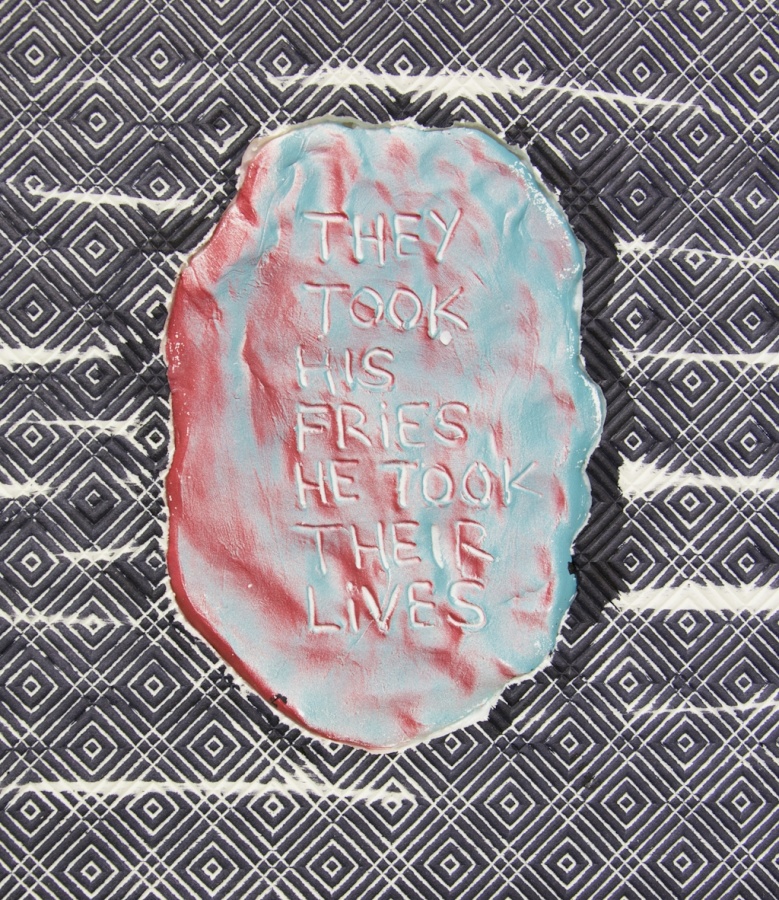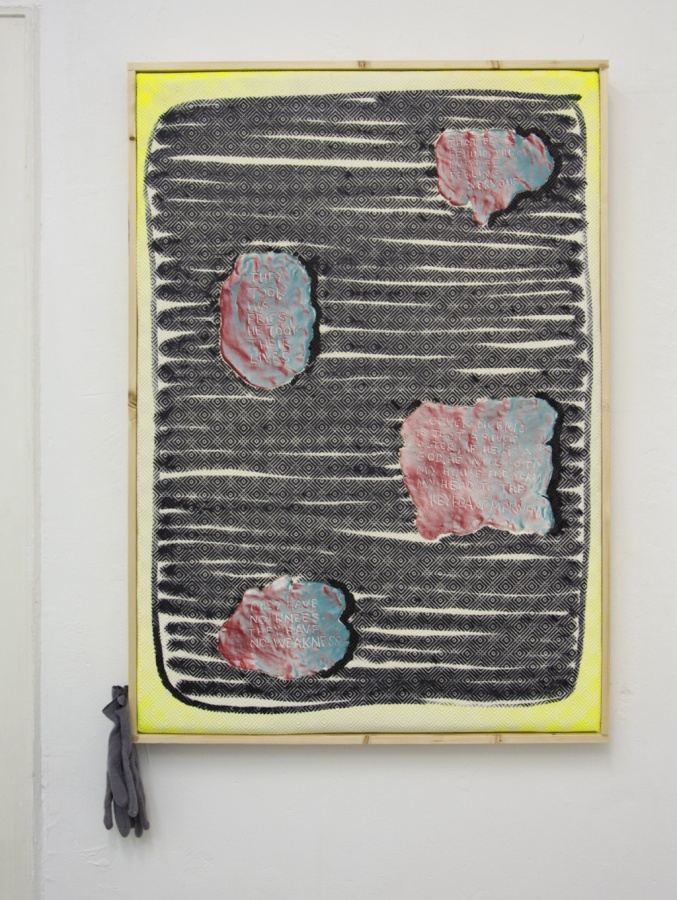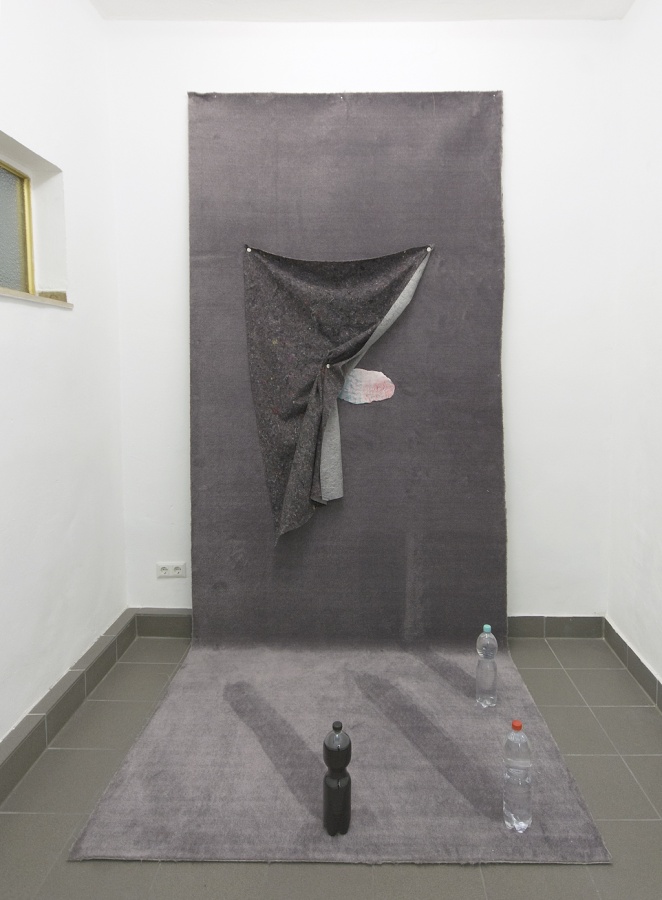THE ADMIRER AND THE ADMIRED…
Jean-Baptiste Maitre & Dina Danish
Translation: Elinor Archer / dutch version
The way objects function in museums is frequently addressed by young artists. They often experiment with this matter from a critical perspective. They might study the functioning of the museum as an institution or the way in which museums include or exclude objects from other cultures. Dina Danish and Jean-Baptiste Maitre begin their quest on the functioning of objects in museums at a formal moment: the way the object functions within a specific entourage. A subtle abstract aesthetic is the first thing you notice when you look at the exhibition.
‘The Admirer and the Admired…’ reveals the results of the research into the functioning of museum display. The exhibition has been exhibited twice before: at the Raum Tyson in Cologne and at the Institute of Art History at the Ludwig Maximilian University in Munich (LMU). It is the first time the two artists have created a work together. Their starting point was a common interest, namely museums and the way in which museum objects are displayed.
Which museums did you visit?
‘We mostly visited museums with archaeological and historical objects’, says Maitre. ‘The presentations were very diverse. In Egypt it was all about archeology. In Paris we visited the medieval Cluny Museum, which has beautiful rugs up on the wall. A presentation of wax seals in a museum in Lisbon was the first reference point for our exposition; they were exhibited in a an amazing framework. That was inspiring. I don’t think people stop to think that things like entourage, the suspension systems, the cabinets and the other display attributes – after taking careful consideration – are skillfully made by hand.’
The other connecting factor is the relationship between exhibition and perception. The way the viewer regards the work changes when the relationship between the object and the museum decor changes. That is what the work ‘Mathematically Incorrect Composition’ is about; a recreated museum frame display in which objects are put up. Like classical avant-garde artists such as Cezanne and Mondrian, Danish and Maitre play a game with foreground and background. Sometimes the artefact, such as a text inscribed clay tablet slides forward. Sometimes, the ratio artefact and surrounding surface is neutral. If the artists replace a museum object by a plant the natural arabesques determine how you experience the background. By making such shifts – mathematical errors, like the title of the work – the attention can be alternately turned onto the background or display attribute.
Besides the changing focus on fore- and background, reversals play an important role in their work. They add contrast and slight absurdity to the work, as can be found in the installation ‘Inspecting Mirrors and Shadows’. In this work everything which is normally attached has been loosened, is haphazard or temporary. In the works containing clay tablets the objects and the inscriptions are alternately demanding attention. For the inscriptions the couple chose quotes from YouTube that, taken out of context, seem informational museum texts without referring to a specific object. The artists manage to consequently highlight new and unexpected hidden relationships between displayed objects and their environment.
How does your work relate to recent ideas about ‘animated objects’?
This is a form of animism which might be raised when as an artist or critic wants to criticize the ‘cool’ presentations in Western museums. [1]
‘We are trying to animate the objects by changing their environment,’ says Danish, ‘but we weren’t responding to the social implication. We were looking for a complementary relationship that would break the hierarchy of a specific relationship, hence the title ‘The Admirer and The Admired…’. These two concepts dovetail nicely. It refers to the male and the female, it fits.’
Danish and Maitre’s study makes for an exhibition in which vulnerable compositional relationships are central. They speak out in favour of the fleeting rather than the fixed; in favour of the temporal rather than the eternal and seem to have a preference for fluid connections and blurred borders. So with a detour we end back up at institutional criticism.
For those fluid connections don’t only exist in abstract art, as in the work of Bas van den Hurk. They also determine changes in presentational form. The work of Tino Sehgal for example is built around a similar strategy. His performances are specific works included in museum collections, but they deny conventional structures. This is how he tries to escape the nineteenth century references.
‘The Admirer and The Admired…’ has interesting topicality. It emphasizes how the formal and the artisan; the abstract and the meaningful merge in contemporary art, creating new forms and meanings.
THE ADMIRER AND THE ADMIRED..│Jean-Baptiste Maitre en Dina Danish │4.3-27.3.2016 │PuntWG
[1] Candice Lin, The longlasting intimaci of Strangers in: Crawling Doubles, Collonial Collecting and affect, Ed.Mattieu K.Abonnenc, Lotte Arndt, Catalina Lozano, Editions B42, 2016




